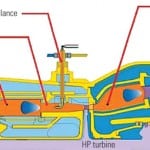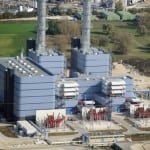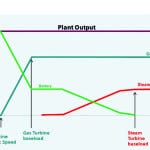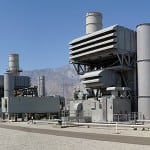The need for flexible power generation has increased drastically over the past few years, particularly when integrating renewables. Another driver is seasonal peaks in demand that have become more severe as global drought conditions have reduced hydropower production. One option for addressing this need is the Siemens Energy SGT6-5000F with Shaping Power. It offers the familiar gas turbine reoptimized for increased output and higher efficiency during hot weather and for improved operating flexibility at part-load conditions.
Slow and stable plant operation, once the norm, no longer meets the needs of the modern integrated and extremely dynamic grid. New generation must be fast and flexible while remaining robust and reliable even under very demanding operating conditions. Gas turbines have always provided very flexible operations compared with other utility-scale generation choices, such as coal. The Siemens SGT6-5000F gas turbine with Shaping Power option is well-positioned to be the technology choice for the 21st-century electricity grid that demands faster and more flexible response, without an efficiency penalty (Figure 1).
 |
| 1. Responding with flexibility. Siemens’ Shaping Power option offers improved operating flexibility with its SGT6-5000F gas turbine. The turbine was redesigned to provide fast-ramping capability that will meet the needs of a dynamic electricity grid. Courtesy: Siemens Energy |
Modern Grid Problems
In the past, gas turbines operated as baseload units, or for peaking power supply for short periods. Baseload units ran at maximum power for extended periods. Peakers were expected to cycle frequently in order to supply additional power when demand increased. A regional power grid in the U.S. might be supplied by a combination of nuclear, coal, wind, and gas-fired generation, with gas ramping on and off or up and down for peaks in demand during the day. An example of daily grid demand and the sources of electricity supply is shown in Figure 2.
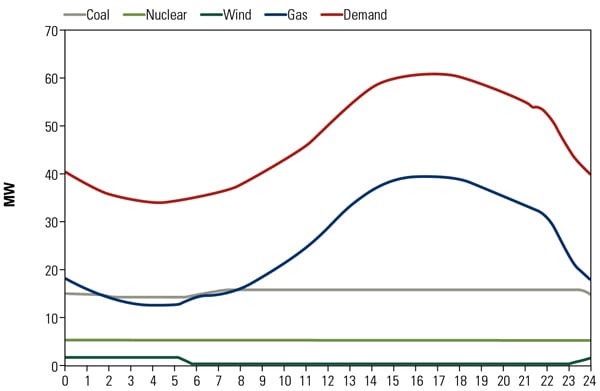 |
| 2. The historical grid. Typical supply and demand curves over a 24-hour day for a traditional grid with a low renewable contribution. Source: California ISO |
The need for fluctuating power supplies, even with this traditional fuel mix, is immediately apparent because the familiar baseload power generation plants were not designed for fast load change following. In response to that need, more flexibility has been introduced into fuel-efficient gas turbine combined cycles over the past few years. Integrated cycles are available with control logic allowing the plant to quickly ramp up and down, reducing startup emissions and startup costs. For example, the Siemens’ Flex-Plant combined cycle series, first introduced in the mid-2000s, improved the efficiency of power generation and increased operating flexibility while reducing the environmental footprint of gas-powered generation.
In recent years, the need for operations flexibility has increased drastically. The introduction of significant amounts of renewable generation created a situation where the fluctuations in demand are not the only driver for the need to change the amount of power supplied by gas-fired generation. The introduction of a significant amount of renewable generation resulted in rapid fluctuations in supply power that must be quickly balanced with quick-acting, and often very expensive, generating sources (Figure 3). While demand is fluctuating during the day, the supply from renewables has a strong influence on the shape of fossil-fired plant response, particularly during off-peak hours.
 |
| 3. The modern grid. Typical supply and demand curves over a 24-hour day for a modern grid with significant renewable generation. Source: California ISO [Editor’s note: This is a corrected version of the figure that appeared in print, where legend line colors for wind and solar were reversed.] |
Renewables, such as wind and solar, are not typically dispatchable generation. Once installed, the operating cost of renewable generation is low, so there is the desire by grid operators to dispatch renewables whenever possible. In some regions, renewables are usually dispatched first, either by utility policy or because renewable generation has the lowest market bid price.
When renewable generation was a small percentage of the electricity supply to the grid, small simple-cycle gas turbines were used as renewable backup. Today, the amount of renewable energy on the grid in some regions is very large, and therefore the need for flexible power has grown. In some regions with large renewable portfolios, ramp rate demands as high as 400 MW/min are required to backstop fluctuating renewable generation. One seldom-used approach is to manage the renewable dispatch to meet existing system response limitations. The more common approach is to use larger gas turbines, usually in combined cycles, that can move in concert with renewable electricity production.
What Is Shaping Power?
The principle behind the design of Shaping Power was to design a combined cycle plant that complements renewable generation rather than clashing with it. The challenge for the designers was to improve the turbine efficiency and power output at part and full load, unlike other familiar power increase processes (see sidebar). These goals challenged designers to conquer the common problem with all gas turbines: Power production drops as ambient temperatures rise. Shaping Power gives the plant owner the option to quickly ramp up or ramp down power quickly, without impact on the life expectancy of turbine components, even at high ambient temperatures.
Gas turbines use ambient air as their working fluid. The amount of air a turbine ingests is controlled by the volume of the engine and the density of the air. On a hot day, a fixed-size turbine will ingest less air mass than on a cold day because the air is less dense. Gas turbine compressors have a maximum flow capability and have some adjustability. Some compressors are adjusted by one row of airfoils that open and close, somewhat like window blinds, changing the amount of air that gets through. Making large adjustments in flow with one row of airfoils results in a decrease in efficiency due to the step change in volume across the row.
Historically, compressors were designed for an operating point near ISO (standard) conditions, and the adjustability was used to ramp up and down. Many newer engines have multiple rows of adjustable airfoils. Using multiple rows allows the change in volume to happen gradually and reduces the efficiency change when the airfoils are closed or opened. Multiple rows of adjustment are used to ramp up and down and improve part-load efficiency. If the efficiency is not changed significantly when the flow is changed, this offers the opportunity to add more range without sacrificing efficiency.
The Shaping Power design adds the advantage of a larger compressor to the flexibility offered by multiple rows of variable compressor airfoils to extend the operating range of the turbine. From the optimized baseload design point, the engine can quickly ramp down by closing the variable airfoils and quickly ramp up by using the additional mass flow through the oversized compressor.
This design is an improvement for two specific reasons. First, Shaping Power is a feature that adds generation in excess of the baseload power the engine produces, even when ambient temperatures rise. This characteristic is advantageous whether there are renewables on the grid or not. The second unique advantage is that significant amounts of power can be quickly and predictably ramped in and out to support the grid when renewables are cycling. In a combined cycle, the plant can be operating before ramping in Shaping Power. The response is quick because the bottoming cycle is already warm and the steam turbine will automatically follow the gas turbine. The result is a quick-responding gas turbine that then produces a fast-responding combined cycle.
The Shaping Power option available on the SGT6-5000F has a turndown that is less than 40% of baseload while remaining in compliance with standard emissions regulations. This package design gives operators the opportunity to go from the lowest turndown point to full Shaping Power at a ramp rate of 30 MW/min per turbine, thus enabling more than 400 MW of ramping capacity from one SGT6-5000F 2 x 1 Flex-Plant at a rate in excess of 60 MW/min. Siemens offers the SGT6-5000F with Shaping Power in all of the Flex-Plant configurations.
How Does Shaping Power Work?
The SGT6-5000F with Shaping Power option begins with the base SGT6-5000F but with an increase in compressor capacity, as discussed above. The turbine runs at the same operating temperature as the base variant, so Shaping Power has no impact on service life. Shaping Power works much like duct firing on a combined cycle. Duct firing supplements the exhaust energy to produce more steam by the heat recovery steam generator. The additional steam produced can then be used to produce full load from the steam turbine, even when the gas turbine is at part load. With Shaping Power, the same process takes place, but it’s the untapped capacity of the gas turbine that is leveraged.
The advantages of Shaping Power grow when temperatures rise. On a hot day, the gas turbine has less flow than it is capable of using. Shaping Power increases this mass flow to fully exploit the unused gas turbine capability (Figure 4). This capability enables a variety of new applications. For example, on a given day, the grid operator can choose how much power to produce. The engine can operate anywhere in the gray region of Figure 4 without any change in operating temperature, and therefore without change in emission levels. The turbine can also operate below the lower line in part-load operation. With an SGT6-5000F, the engine can also operate at levels of less than 40% load in standard emissions compliance, so the range of output available is substantial.
 |
| 4. Less temperature sensitivity. The SGT6-5000F with Shaping Power will produce more power for a given ambient temperature. Source: Siemens Energy |
In combined cycle mode with duct firing active, the capability of Shaping Power is clear: User-specified power is produced at a lower heat rate from the same bottoming cycle (Figure 5). From another perspective, Shaping Power moves the optimum design point to a point lower than the maximum power output of the engine. The difference is that the unit with Shaping Power has about 10% more power capability when operating at its highest efficiency.
 |
| 5. Improved efficiency. Shaping Power produces a given amount of power at a lower heat rate in a duct-fired combined cycle. Source: Siemens Energy |
In some regions of the U.S. with a large portion of renewable generation, gas-fired plants are tasked with filling in the voids when renewables generation fluctuates. If your combined cycle is a Flex-Plant with gas turbines configured with Shaping Power, then you have the option to run the plant at part load and keep the remaining capacity as spinning reserve. In the Electric Reliability Council of Texas, this capability is called an ancillary service and has a market value.
The spinning reserve option has much economic value because an SGT6-5000F with Shaping Power reaches optimum efficiency at about 10% below maximum engine load. This extra 10% can be ramped in on demand to compensate for the unexpectedly lost renewable generation. In effect, an SGT6-5000F with Shaping Power functions like a high-efficiency combined cycle with a small peaker unit built in.
Shaping Power Status
All Siemens 60-Hz gas turbine designs go through full-load validation testing at Siemens’ full-scale engine test facility in Berlin. The SGT6-5000F with Shaping Power was tested from 2007 to 2010 before market introduction in early 2011. This configuration was tested for more than 395 engine operating hours and 1,500 engine starts. The hot gas path is common with the standard SGT6-5000F that entered commercial service in 2009. To date, 24 SGT6-5000F engines with Shaping Power have been ordered, and the first unit is scheduled to begin commercial operation in 2012. The SGT6-5000F with Shaping Power is being manufactured at Siemens’ expanded manufacturing facility in Charlotte, N.C.
— Bonnie Marini, PhD (bonnie.marini@siemens.com) is director, 60-Hz product line marketing for Siemens Energy.







